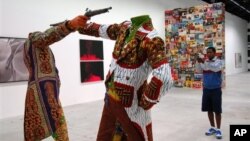Fifty-three countries worldwide are proud to have pavilions at the upcoming 2015 Venice Biennale, considered by many the Olympics of the contemporary art world.
Kenya, whose artists have only recently begun to make a name for themselves internationally, mounted its third pavilion this year. But when Kenyan artist Wambui Kamiru saw the 2015 pavilion lineup, she was furious to find only one artist was actually Kenyan.
“It is like people have just chosen to step into my space and decided that I do not exist as a Kenyan artist," said Kamiru, a Nairobi-based abstract impressionist whose work addresses topics of colonialism and African independence. "They thought it was all right to bring somebody from another country to represent my voice, so of course I felt naturally angry about it. That is my flag, not someone else’s flag.”
Of the eight artists featured in the Kenyan pavilion, six are Chinese, and only one ethnic Kenyan, Switzerland-based Yvonne Amolo — "a film maker, radio presenter, actress, dancer, fashion designer and yodeler" — made the list. According to one news report, Amolo lacks close ties to the contemporary Kenyan art world.
Armando Tanzini, an Italian-born painter and sculptor who has worked in coastal Kenya for decades, and whose work was featured in past Biennale pavilions, is the only other Kenyan citizen who made the 2015 roster. According to Africa Is a Country, a digital journal on contemporary African art and culture, Tanzini is also a wealthy hotelier who is running this year's pavilion.
While this year's Biennale doesn't kick-off until May 9, the Kenyan pavilion has already caused such uproar that Hassan Wario, Kenya’s minister of culture, announced the government is officially disowning it.
It is not clear exactly how the pavilion came to be dominated by Chinese artists. Tanzini has said he put thousands of dollars of his own money into the exhibition, without which it would not have happened at all.
But Sylvia Gichia, who heads the Nairobi-based Kuona Trust Centre for Visual Art in Kenya, says she would prefer to have no pavilion rather than a pavilion that looks like this one.
“We would much rather not be represented than be represented fraudulently and in the wrong way," she said. "Would we like it to be a Kenyan space? Yes. Would we like to have Kenyan artists in the pavilion? Absolutely. We just will not stand to be misrepresented.”
Kenya’s artists could certainly use the international exposure, she adds, explaining that that the country’s art scene is growing fast and attracting increased global recognition.
“It is buzzing. We are attracting a lot of international attention because of the actual work that is being created by artists from this space," she said. "International art buyers are buying work from the East African region. We have artists like Paul Onditi, Miriam Kyambi, James Muriuki, and the list can go on and on.”
This is not the first time foreign artists have stepped in to represent Kenya at Venice. The country’s 2013 pavilion was heavily Chinese as well.
Gichia is determined not to let it happen again; she and others in Kenya are working with the Italian embassy to figure out how to mount a more representative pavilion for the 2017 Biennale.
But doing so is an expensive undertaking. A visual artist who works from Kuona Trust, Thom Ogonga, is not convinced the government will pay for it, or that Kenya’s arts infrastructure is developed enough to put a pavilion together.
“We need to do a lot of housekeeping," he said. "For example, if somebody volunteers to fund a proper Kenyan pavilion in Venice, who is going to run with it? We do not even have a proper curator. We do not have an arts council. I think in Kenya what we need is to get our act together.”
As for this year’s Biennale pavilion, it will still be on display, but will no longer bear the Kenyan flag, which Gichia considers to be a victory in itself.





